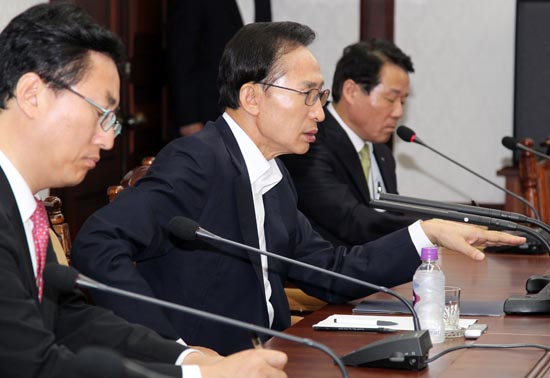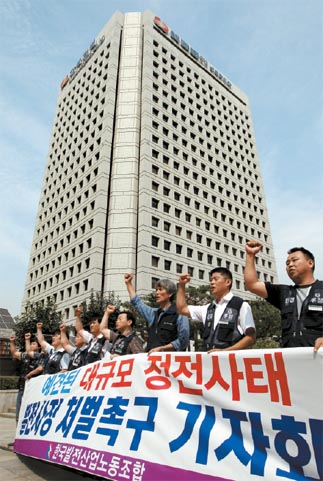After blackouts, MB lashes out at Kepco execs, KPX

President Lee Myung-bak, center, urges officials at the Korea Electric Power Corporation to come up with measures to thoroughly respond to Thursday’s power outages, at Kepco headquarters in Samseong-dong, southern Seoul. On the left is Knowledge Economy Minister Choi Joong-kyung and on the right is Kim Woo-kyum, Kepco vice president. [YONHAP]
President Lee Myung-bak visited the headquarters of the Korean Electric Power Corporation and harangued its management for the blackouts that affected broad parts of Korea Thursday.
“I’m not here to listen to your briefing,” he told top executives at Kepco headquarters in southern Seoul yesterday afternoon. “You are saying Kepco is a world-class company, but have you thought about patients in hospitals and small and medium-sized companies without electricity? Find out who is responsible!”
Lee talked to the executives for about 30 minutes. Also at the meeting was Minister of Knowledge Economy Choi Joong-kyung.
“Kepco, the Ministry of Knowledge Economy and Korea Power Exchange are all responsible,” Lee said. “You have done something that should never happen. I feel ashamed of even talking about it.”
More than 1.62 million families across the nation faced power outages Thursday without any notice, and the government is taking heat for the unprecedented blackouts.
People were trapped in elevators, factories were forced to halt production and hospitals in many cities lost power for a while.
Civic groups as well as netizens posted critical comments online throughout yesterday about the government’s failure to prevent the chaos by anticipating a surge in demand after an unusual - but predicted - rise in temperatures.
An increasing number of people and companies that were directly or indirectly affected by the blackouts are planning on filing class lawsuits against the state-run Korea Electric Power Corporation (Kepco), which is in charge of the country’s power.
What went wrong?
On Thursday afternoon, the Korea Power Exchange (KPX), which is under Kepco, temporarily cut power supplies for major cities as electricity demand reached a peak due to high daytime temperatures.
At 3 p.m., Korea’s power consumption reached 67.28 million kilowatts, which is much more than KPX’s prediction of 64 million kilowatts. To preserve the country’s electricity reserves, it intentionally cut power by starting rolling blackouts to prevent an overload.
The country’s reserves had dropped to 3.4 million kilowatts, which is far below the 4 million kilowatt level that is considered a safe margin.
Electricity was fully restored before 8 p.m., ending the nearly five-hours of blackouts. Power reserves were restored to 4.8 million kilowatts.
“Unusually high temperatures led to a surge in power demand, which spurred an overload amid ongoing maintenance of some power plants,” said Knowledge Economy Minister Choi. “Temporary power cuts lasting for 30 minutes per region were inevitable.”
Mounting damage, complaints

Employees of the Korean Power Plant Industry Union protest Thursday’s blackouts yesterday at Kepco headquarters in Samseong-dong, Seoul. [YONHAP]
In industrialized zones such as Ulsan, where factories run by SMEs are concentrated, around 20 manufacturing firms had to halt production due to the outages. Large companies such as Samsung Electronics, Hyundai Motor, SK Energy and Posco said they were not affected because they have their own power stations for emergencies. Butcher shops and restaurants lost power in their refrigerators, causing vegetables and meat to lose freshness.
“There should be proper compensation from the government for those that have been emotionally and economically damaged,” the Citizens’ Coalition for Economic Justice said in a statement yesterday. “If not, we are planning on filing a class suit to promote the public interest.”
In response to the criticism, Knowledge Economy Minister Choi said yesterday to lawmakers, “The government will positively consider the matter of compensation.” He said, “The country’s power reserves [on Thursday] were lower than expected and if Kepco did not cut power supply at that moment, it could have caused a much bigger problem, perhaps requiring more than 40 hours to restore power supply.”
Who’s to blame?
Although the government knew the temperature would keep rising after the Chuseok holiday, based on the weather forecasts, it failed to adjust its power demand volume. In fact, the government even stopped operations of 23 power generators nationwide, which can supply 8.34 million kilowatts of energy, or 11 percent of total capacity, for maintenance. Normally, the government partially turns off generators in the spring and fall for maintenance after power demand drops.
The ministry was careful to keep the power supply and demand in balance during the summer and winter. And based on unusually sultry weather this year, it extended the emergency power supply period by one week from June 27 to Sept. 9 and enhanced monitoring. Last week, the ministry even patted itself on the back for successfully managing the peak period, saying that its “preemptive measures and policies enabled the country to get through the summer without any crises.”
But as the hot weather continued after Chuseok, the ministry nodded off to sleep at the wheel.
“We failed to predict the flow of power demand,” said Do Kyung-hwan, an official at the Knowledge Economy Ministry in charge of energy industry.
Industry analysts blame the country’s low electricity rate compared to other developed nations, which produces more demand. In 2010, Korea’s electricity charges covered only 90.2 percent of the cost of producing the power.
“The fundamental reason for blackouts is the country’s cheap electricity price,” said Chung Han-kyung, head of the electricity department at the Korea Energy Economics Institute.
By Lee Eun-joo [angie@joongang.co.kr]
한글 관련 기사 [중앙일보]
“정전 책임 묻겠다”
한전 찾은 MB “변명 말라”
어제도 예비전력 아슬아슬
“대우받을 건 다 받는 공기업, 수준은 형편없어”
이명박 대통령은 16일 ‘정전 대란’ 사태와 관련해 “기본을 지키면 일어날 수 없는 일이 일어났다”며 “한전, 지식경제부, 전력거래소, 발전소는 사과해야 한다. 변명할 필요가 없다. 안 일어날 일이 일어났기 때문이다”라고 말했다. 서울 강남구 삼성동에 있는 한전 본사를 방문한 자리에서다.
이 대통령은 “이런 실수가 일어나 정부가 국민 앞에 고개를 들 수 없다”고 했다. “부끄럽고 미안하고 죄송하고…”라는 말도 했다.
이 대통령은 “일반 제조회사도 고객을 (생각)해서 하는데 공기업이 대우 받을 건 다 받고 수요자에 대한 생각을 전혀 안 하는 것”이라며 “여러분 수준이 형편없는, 후진국 수준”이라고 지적했다.
이 대통령은 또 “당신들은 잘 먹고 잘 자고 있다가 수요가 올라가니 끊어버리겠다는 이런 생각으로 (정전)한 것 아니냐. 이 책임을 여러분이 통감해야 한다 ”고 일침을 가했다.
그러면서 “이건 분명히 책임 소재를 따지겠다”고 말했다.
이 대통령은 “국민이 전기가 이런 사정이어서 끊을 수밖에 없다는 걸 알고 있으면 대비하고 감정적으로도 얼마든 이해할 것”이라며 “이번 일 때문에 나도 분통 터지지만 함께 국민 앞에서 미안한 마음을 갖는다”는 말도 했다. 그런 이 대통령의 질책은 35분간 계속됐다. 이에 앞서 이 대통령은 한전이 당초 회의장으로 잡은 별관 5층이 극장식 구조인 걸 보고 나서 “여기서 회의를 할 수 있겠느냐”고 질책했고, 한전 측은 두 차례 회의장을 옮겼다. 이 대통령의 한전 방문에는 최중경 지식경제부 장관, 김대기 청와대 경제수석, 박정하 청와대 대변인, 강남훈 지식경제비서관 등이 수행했다.
한편 16일도 높은 기온으로 예비 전력이 바닥 수준으로 떨어졌다. 한국전력거래소는 이날 오후 1시40분쯤 ‘전력 수급 경보’를 발령했다. 오후 기온이 30도를 넘어가면서 예비 전력이 400만㎾ 아래로 내려가면서다. 예비 전력은 오후 2시40분쯤 310만㎾(전력예비율 4.9%)까지 떨어지기도 했다. 전국적 정전 사태를 촉발시킨 15일의 예비 전력 최저치는 148만9000㎾였다. 비상조치는 오후 3시 이후 전력 수요가 줄어들면서 해제됐다.










with the Korea JoongAng Daily
To write comments, please log in to one of the accounts.
Standards Board Policy (0/250자)